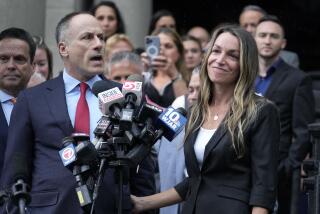Peyer Jurors Cite Lack of Motive, Evidence
- Share via
Two jurors in the trial of former California Highway Patrol Officer Craig Peyer said Thursday that the jury became hopelessly deadlocked because five members believed the prosecution had shown either no clear motive or insufficient evidence that Peyer murdered Cara Knott.
“The big thing that caused the deadlock today was the possible motive,” said Victor T. Dingman of Escondido, who was among the five who voted against conviction.
“Peyer, being a model officer--what possible motive could have led to an out-of-control situation to cause this incident to happen?” Dingman said.
Tense Sessions
Gregory Cadice, a holdout who changed his mind Thursday morning and in the end voted for conviction, said jurors who believed Peyer was guilty tried repeatedly during tense sessions to persuade the others to convict him.
“I think he’s guilty,” said Cadice, 62, of La Mesa. Cadice said he was “on the fence” Thursday morning, but went through all the evidence again and changed his mind.
“I say that Peyer was seen,” he said, referring to witnesses who placed Peyer at the murder scene. “I say that Cara was there at that point in time. I say that she was taken down, under the bridge. . . . Something occurred, and all I know is the girl stayed down there dead and Peyer came up with scratches on his face.
“If he was innocent, then who in the hell did it? Because that girl was brutalized,” Cadice said.
But Dingman said that “it would appear that they built a set of circumstances around Craig Peyer to fit the public outcry.”
Although much was made of the scratches on Peyer’s face that several witnesses said they saw the night of the murder, Dingman said they didn’t play a major role in the deliberations. Peyer’s defense said the scratches were the result of a fall that caused him to hit his face on a chain-link fence.
“I stuck my face to a chain-link fence, and those crossbars on the fence come right up to the corner of your eye,” Dingman said.
He also said the prosecution’s evidence allegedly linking blood and fibers found on Knott’s body to the former officer was not persuasive.
“There was not that much weight about the blood and fibers because of the inability to show conclusive evidence,” Dingman said. “There was not a shred of conclusive evidence in the fibers and blood.”
Both Dingman and Cadice said they jury gave little weight to the testimony of 23 women who said Peyer had stopped them near the same location and questioned them at length.
“He had a propensity to stop good-looking gals,” Cadice said. “That didn’t prove anything. He could have stopped Cara, that’s all it proved.”
Dingman said he believed the testimony of the women but that it wasn’t enough to sway his mind.
“The young women were pretty well-accepted. The fact that Mr. Peyer pulled people off wasn’t as big a factor as many might have thought,” he said. “Even if the girl (Knott) overreacted and exploded . . . there was a lack of motive. Peyer could handle it.
“The worst scenario would be that he puts the handcuffs on her. . . . (There’s) no rational conclusion that could be drawn for a motive under any circumstances and with his experience,” Dingman said.
The testimony of Dwayne and Ann Clinkscale, who were parked near the scene of the killing, was credible but vague, he said. “In my mind, the Clinkscales and the other people were very credible. The only problem was the vagueness in their testimony,” he said.
“We thought Peyer could have been there, but the vagueness of the witnesses became a hindrance.”
Cadice said the jury worked up a flow chart to indicate when various events happened on the night of the murder, and he said jurors “were sincerely trying to understand what took place.”
Some refused to vote for conviction because they thought “there just wasn’t anything there that says that Peyer actually caused the death of the girl,” Cadice said. “They could go up to the point that he could have stopped her and taken her to the bridge, but from that point on there’s nothing that they would have accepted or rationalized.”
According to Dingman, the five jurors who voted for acquittal were himself, Carole Riggs of Rancho Bernardo, Sharon Beale of Alpine, Joseph Dorner of Kensington Park and William Devine of Paradise Hills.
The other jurors were Robert L. Harrell Jr., Escondido; Lawrence Endriss, Escondido; John Doxey, Rancho Penasquitos; Patrick Coady, Carlsbad; George F. Boutell, Clairemont; Gregory Cadice, La Mesa, and Walnetta A. Lenhardt, San Ysidro.
More to Read
Sign up for Essential California
The most important California stories and recommendations in your inbox every morning.
You may occasionally receive promotional content from the Los Angeles Times.













